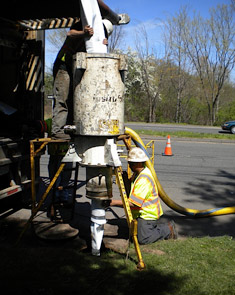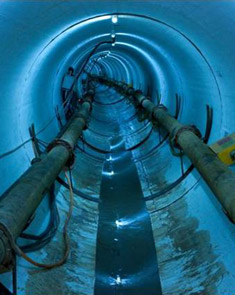The Solution: The Five Components
The Clean Water Project is a plan designed to control and reduce the overflow of untreated sewage into local waterways.
While it's impossible to get all the stormwater out of the system, in order to meet the guidelines and deadlines of the government mandates, and design a cost efficient approach, the MDC developed a five component solution for the Clean Water Project.
The 5 Components of the Clean Water Project
Inflow and Infiltration
 The first priority for MDC customers is limiting stormwater entering the system. It begins with what is called “inflow,” which refers to stormwater coming from customers’ homes and entering the sanitary sewer pipe. Stormwater from down spouts, foundation drains, driveway drains and sump pumps overload the main sewer during periods of rain, causing a mixture of sewage and stormwater to overflow into the street, basements and local waterways.
The first priority for MDC customers is limiting stormwater entering the system. It begins with what is called “inflow,” which refers to stormwater coming from customers’ homes and entering the sanitary sewer pipe. Stormwater from down spouts, foundation drains, driveway drains and sump pumps overload the main sewer during periods of rain, causing a mixture of sewage and stormwater to overflow into the street, basements and local waterways.
“Infiltration” refers to all of the water leaking into the sewers from cracked or broken pipes and laterals, faulty pipe connections, or deteriorated manholes. As part of Phase I, the MDC has been busy making improvements in your neighborhoods incorporating a process called “pipe lining”, a process where resin-coated felt tubing is pulled into the existing pipe. Steam is then circulated throughout the tubing, curing the resin and forming a tight-fitting, corrosion-resistant “pipe-within-a-pipe”. This non-invasive method of sealing the sewer pipes is less disruptive to neighborhoods and businesses, highly cost effective, and extends the life of the pipe for up to 50 years.
The MDC encourages homeowner participation through distribution of rain barrels, and education on disconnecting sump pumps and down spouts from the sewer system;
- Holding discussions with towns about additional strategies and solutions to reduce stormwater connections to the sewer system; and
- Working with member towns to redirect clean water away from the sanitary sewer system by improving local drainage systems.
Sewer Separation
.jpg) The second component is aimed at separating the old combined sewer system. The sewage traveling from the suburbs must flow through parts of the sewer system that were built in the 1840's for a population of 30,000--- not the 400,000 people in the eight member towns the MDC serves today. Several sections of the system were later upgraded with a pipe technology widely used in the 1930s, called a “combined sewer system."
The second component is aimed at separating the old combined sewer system. The sewage traveling from the suburbs must flow through parts of the sewer system that were built in the 1840's for a population of 30,000--- not the 400,000 people in the eight member towns the MDC serves today. Several sections of the system were later upgraded with a pipe technology widely used in the 1930s, called a “combined sewer system."
Many urban areas, including Hartford, utilize this system. One pipe in the street carries both sewage and stormwater. But when the system's volume is increased by stormwater, it easily overflows into our streets and homes.
In a typical sewer separation project, a second pipe is added in the street. In this example, the new pipe will serve as a sanitary sewer for household waste, and the existing combined sewer will remain in place as a dedicated storm pipe. Once construction of the sewer separation project in the street is complete, a new second pipe, or lateral, must be connected to each and every home and business.
Storage Tunnels
The construction of two storage tunnels is the largest construction component of the Clean Water Project. The South Hartford Conveyance and Storage Tunnel is 18-feet in diameter and four miles long. It will be able to store over 40 million gallons of sewage until such time as this stored sewage can be treated at the Hartford Treatment Plant. This will prevent raw sewage from overwhelming the plant and spilling, untreated, into the Connecticut River and its tributaries. The South Storage Tunnel will handle sewage from West Hartford, Newington, and Hartford.
Interceptor Pipes
 When the sewage and stormwater flowing from District towns is combined, it exceeds the capacity of the existing sewer pipes. Large “interceptor pipes” must be installed to increase capacity and convey the flow to the treatment plant.
When the sewage and stormwater flowing from District towns is combined, it exceeds the capacity of the existing sewer pipes. Large “interceptor pipes” must be installed to increase capacity and convey the flow to the treatment plant.
The largest project in Phase I was the installation of a mile long, five-foot diameter interceptor pipe on Homestead Avenue, a project that has won the National 2011 Public Works Project of the Year for the first-time use of curved micro-tunneling technology in the United States.
Treatment Plant Improvements
.jpg)
Another major initiative is increasing the capacity of two of the treatment plants in the sewer system—critical upgrades that will provide the largest environmental benefit. The Hartford Plant treats sewage from Bloomfield, West Hartford, Newington, Hartford and portions of Wethersfield and Windsor. The smaller Rocky Hill plant treats sewage from Rocky Hill and Wethersfield. These improvements will allow the facilities to be able to treat more flows coming from the sewer systems and also reduce the amount of nitrogen discharged into the Connecticut River and ultimately Long Island Sound. Additional improvements will use excess heat from the treatment process to generate nearly 40% of the Hartford Treatment plant’s total electricity needs, reducing costs and carbon footprint.
Construction at the Hartford Treatment Plant includes the following projects:
- Wet Weather Expansion
- Biological and Nutrient Removal Phase II (complete)
- Ultraviolet light disinfection project (complete)
- Heat Recovery (complete)
- Aeration and Final Settling Tank Upgrades (complete)